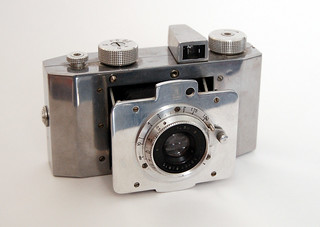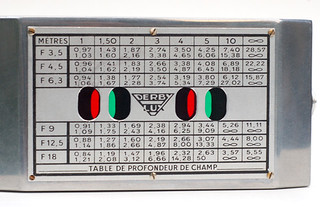Derby-Lux and Derlux
| |||||
| German, French & Italian Cameras using 127 film | |||||
| G e r m a n y |
3×4 | rigid | Dreivier | Futuro | Gewirette | Kolibri Parvola | Pupille | Ranca | Reporter | Puck | ||
| folding | Baby Ikonta | Baldi | Dolly | Goldi Gucki | Ingo | Korelle | Makinette Metharette | Perkeo | Vollenda | ||||
| 4x4 | Navax | Paxina Electromatic | Rothlar | ||||
| 4x6.5 | Bella | Billy | Bob | Dolly | Goldi Gucki | Korelle | Panta | Parvola Piccolette | Rio | Ultrix | ||||
| TLR | see German TLRs | ||||
| F r a n c e |
3×4 | rigid | Fotobaby | Lynx | Super-Boy | ||
| folding | Derby-Lux | Elax | ||||
| pseudo TLR | Auteuil | Longchamp | ||||
| 4×4 | rigid | Impera | Marly | Pari-Fex | Rubi-Fex | Top | |||
| 4×6.5 | rigid | Photo-Magic | |||
| I t a l y |
3x4 | Comet | Comet III | Cometa | Euralux Ibis | Maxima | Piccolo | Tanit | |||
| 4x4 | Comet | Euralux | Ibis | ||||
| 4x6.5 & other | Alfa | Delta | Relex | Rolet | Rondine | ||||
The Derby-Lux — made by Gallus of Paris, c.1945 — was a continuation of the 1930s German Foth Derby, whose production had been taken over by the Gallus company after Foth moved to France.[1] Gallus changed the name in 1947 to the Derlux.
It is a strut folding camera with body and lens panel made of polished aluminium. Most examples have a Gallix 50mm 1:3.5 three-element focusable lens, made by Gallus itself; some have the well-regarded and faster Berthiot Flor f/2.8, or the Boyer Saphir f/3.5 or f/2.8.[2] There are four windows, two red and two green, on the back for the 127 film, surrounded by a depth-of-field (profondeur de champ) table.
The speed of the focal plane shutter is controlled by the large knob on the top, marked from 1/25–1/500s + B.

|
| Gallus Derby-Lux, Saphir f/3.5 lens. image by John Kratz (Image rights) |

|
| Back of the camera, opened to show the red & green windows, depth-of-field table, and the Derby-Lux name. image by John Kratz (Image rights) |
Notes
Bibliography
- Vial, Bernard. Histoire des appareils français. Période 1940–1960. Paris: Maeght Éditeur, 1980, re-impressed in 1991. ISBN 2-86941-156-1.
